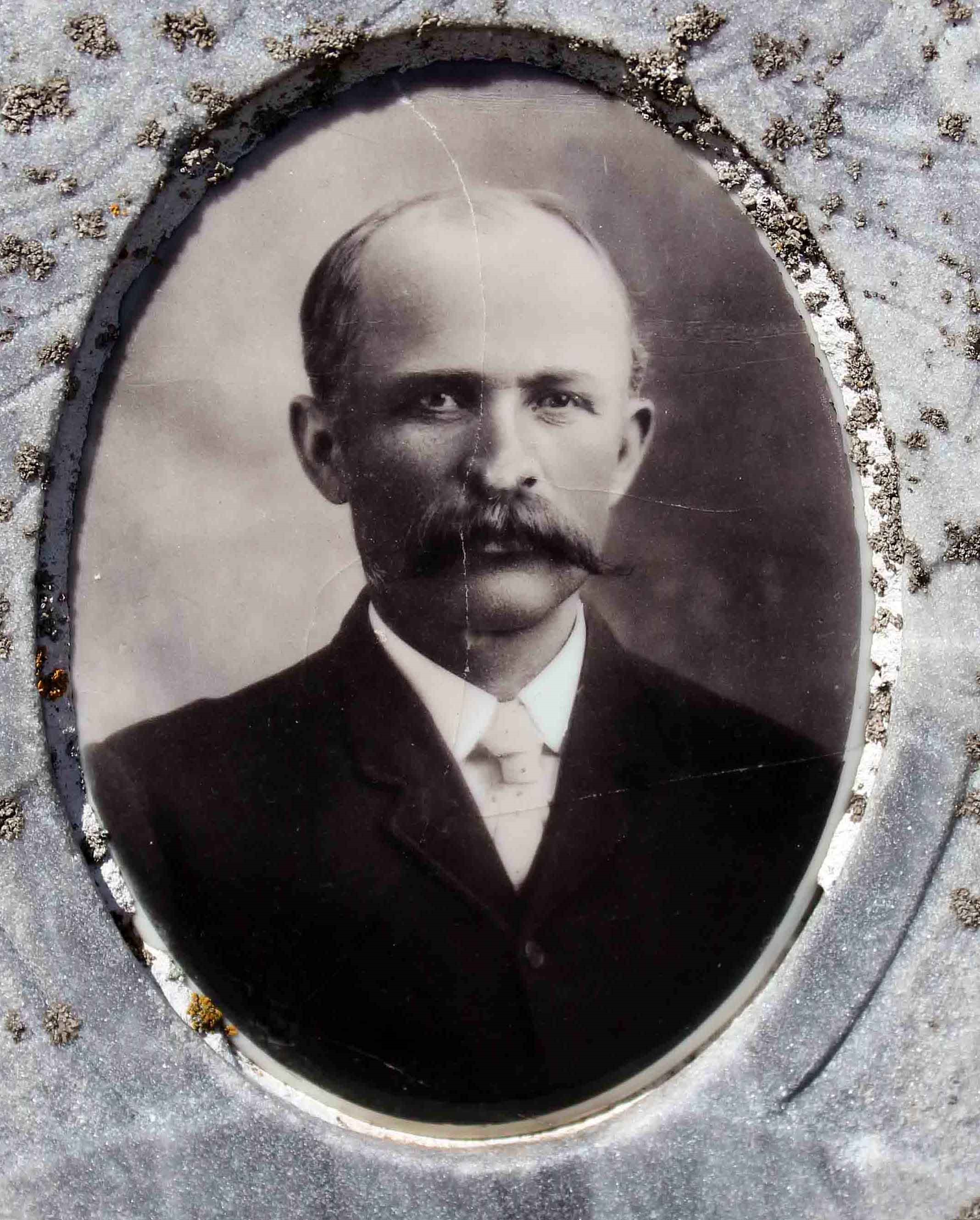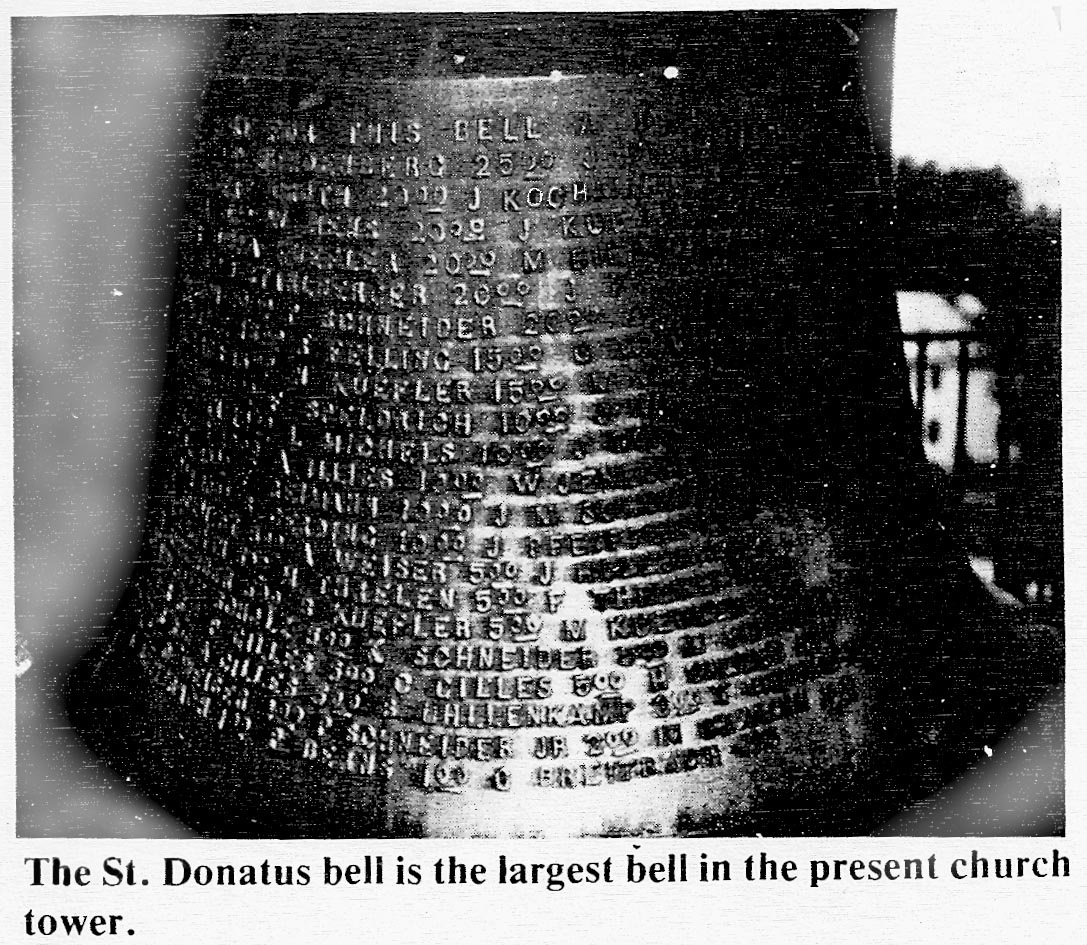My Least Known Grandparent Julius Kochmann by Jerry Thompson
When I first thought about writing a family history post for the 52 in 52 Challenge, I Immediately thought of writing about my maternal Grandpa Julius Kochmann. Of my four grandparents, I know least about him, partly because he died when my Mom was just six years old in 1918, so I'm not sure if Mom knew him that well either. Julius is one of my little brick-wall mysteries since I don't know which exact village or region he came from in Germany, (actually Prussia), nor exactly when he arrived in North America (Census records indicate 1883). A reason for writing this article is also to check today's internet sites to see if recent updates might solve some of the brick walls, and to do an action list of what sources to explore further.
Image - Julius Kochmann

What do I know about Julius? He was born in Prussia about 1865, probably came to America in 1883, and settled in Lake George Minnesota, Stearns County. He purchased farm property there before 1896. Platt map records from 1896 and 1912 show he owned a 160-240 acre farm near Lake George where my Mom was born and raised (b. 1912). The earliest census I've found him in is the 1895 U.S. Minnesota State Census which shows him living in Lake George Township. The 1890 U.S. Federal Census records were mostly destroyed in a fire including those for Minnesota, so there is no 1890 record of Julius. One mystery is why he doesn't appear in the Minnesota State 1885 Census. He should be there since the 1895 census indicates he was a Minnesota resident 11 years previous (1884) and resided in Lake George Township since 1887. Why did he immigrate to America at age 18 in 1883 I wonder? My best guess is he wanted to escape the war-torn country following the Franco-Prussian war ending in 1871, and the subsequent period of religious interference caused by Kaiser Wilhelm and his minister Otto Bismarck, particularly against Catholics, which included Julius's family. The anti-Catholic movement became known as the the Kulturkamph that made the minority Catholics feel understandably persecuted during that period.
Before he met my grandmother, Julius first married Ottilia Pfiefer about 1886 and they had 8 children over 12 years, in typical Catholic fashion. Tragically, Ottilla died in September 1899, probably related to bearing another child. Sometime after Ottilia died, all their children went to live with an Aunt in Mahnomen, Minnesota, where they apparently grew up apart from their father Julius, who remained on his farm near Lake George.
Sometime around 1905 Julius met my grandmother Elizabeth Schneider, who was 18 years his junior. They probably met at church. I only have one picture of Julius, which is probably excerpted from his wedding photo with my Grandma Elizabeth. This particular photo is probably taken from the preserved copy located on his gravestone marker at the St. Francis De Sales cemetery near Belgrade Minnesota, see attached picture of Julius. In his second marriage to Elizabeth, they had six children in ten years between 1906 and 1916.
I know my Grandpa Julius was a loyal Catholic and regular church supporter. On a visit I made in 2011 to the Stearns Museum of History, the staff did a search for records on Julius and other ancestors and they turned up this story about donations to buy a new fantastic bell for the Catholic Church. In 1901, the new bell, which was cast at Henry Stuckstede Bell Foundry in St. Louis, cost $544, which was no small amount in 1901. My grandpa Julius donated $20 towards the bell as did 14 other $20 contributors in the area, plus many of lessor amounts. By my quick estimate, that $20 in 1901 would be equivalent to about $5000 today. This bell is called the St. Donatus bell and I think it is still in use in the bell tower of Saints Peter and Paul's church in Elrosa, near Lake George. I am sure grandpa Julius was proud of his contribution to the bell since the names of all who contributed are inscribed and cast into the outer periphery of the bell. In the attached photo you can (barely) make out Julius's name in the third row of text near the center. Other relatives of my family shown on the bell include three Schneiders, and five Kueflers, plus many who are "could-be" in-law cousins like the Fellings, Weiser's and a Stalberger. I hope to find more info about this special bell, and hopefully obtain a better photo than the one I scanned from a reprographic page.
Image - Donatus Church Bell

My most recent visit to the Lake George/Elrosa Minnesota area was in 2011 when I attended a 90th birthday celebration for my Mom's cousin Raymond Schneider. It was a great time and reunion, and I had fun talking to many cousins including Raymond's brother Eddie. He told a story about grandpa Julius he had heard from my uncle "Plug" Kochmann, that Julius was the first farmer in the area who started a scientific system where he would weigh the daily milk produced by each cow and use those records to do selective breeding to systematically improve his milk production, and it seemed to be successful.
One lesson I've learned during the writing of this article is that I'm very deficient in good record keeping practices. I distinctly recall getting a copy of grandpa Julius's obituary article that appeared in the Lake George German paper in April 1918. Somehow I've lost that clipping and need to cover that research path again via the Sterns County History Museum. My recollection of the obit, which a German neighbor friend translated, is that Julius was said to be a fair minded and hard working farmer who was well respected and very dedicated to his church and family. The more I learn about him, the prouder I am of his heritage.
As I mentioned above, one brick-wall mystery is that I don't know exactly where in Prussia Julius came from, but I have a few hints and guesses to explore further. My family script knowledge, no doubt from my Mom, indicated he was from an area of Eastern Germany, but no specific village was ever mentioned. This East German hint or rumor is corroborated by my first cousin Robert Kochmann. A further hunch is a comment I found in a local history book on Elrosa Minnesota (Elrosa, the first 100 years 1908-2008), authored by another cousin, Joe Bayer. In the Elrosa book there is a paragraph that states that most of the early settlers of Lake George and Elrosa came from either northwest Germany near the Belguim-Luxemburg-Holland borders, or an area of East Germany called Neisse in Silesia. Neisse became part of Poland after WWII and the Polish name is now Nysa, Poland. At the end of WWII, the Allies signed an agreement at Potsdam to officially forcefully move all Germans out of that area to make it 100% Polish to avoid any threat of future German aggression from that area. Regarding Catholic Church records for that region, there is some good and some bad news, according to some genealogy blogs I've read. The good news is that the early German/Prussian Catholic records mostly still exist and were not lost in the wars. Part of the bad news is that this region has never been microfilmed by LDS or digitized in any form. Furthermore, bloggers say that getting access to the records is difficult because the churches now have Polish priests who do not read German, have no staffs doing anything genealogical and are very busy with their church duties. Typically, appointments to try to access any records have to be made far in advance and can only be done when the priests have time, since the policies are that no visitors are allowed unescorted access to church books. Apparently years ago when free access was allowed many pages of the records ended up being torn out and lost. Any researcher has to also bring his or her own translator to read and interpret the "old German script" handwritten text to identify the information, and also communicate with the Polish clergy. Kind of a grim outlook for finding grandpa Julius's roots and homeland.
Regarding research, most professional genealogists emphatically state that to "cross the pond" successfully when researching you must for sure identify the correct village area from info found on this side, from North American sources. Therefore my best hope is to be able to research and delve into church, land, cemetery, probate, and related family records in Stearns County to try to identify the village where Julius came from. I've already learned some new facts about Julius by doing this article, so I have high hopes for discovering more! I am very indebted to the Stearns History Museum for their generous support of my inquiries, including their permission to obtain copies of a large part of a Kuefler Family Genealogy book entitled The Heart of Herresbach, by Father Juniper Kuefler of Galahad Alberta, southeast of Edmonton. Hence, my thanks go to both the Stearns Museum and the late Father Kuefler for all the rich family history information. Also, I thank my cousin Joe Bayer for his wonderful Elrosa history book. Without these sources I would know far less about Julius and the Lake George region of Minnesota.
A final comment about grandpa Julius is that when he died in 1918, he was only 53 years old, and died of cardiovascular failure or stroke of some sort. That's thought to be dying at a young age today, but sources indicate a male's life expectancy around the 1910's was only 47 years. Hence Julius did better than average for his day, and I feel very lucky to be approaching my 75th Birthday this year.